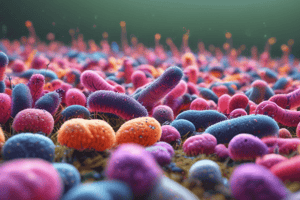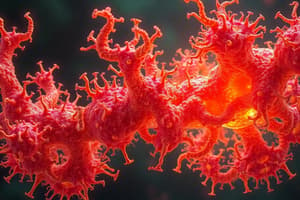Podcast
Questions and Answers
What characteristic does Yersinia enterocolitica exhibit when cultured on MacConkey agar?
What characteristic does Yersinia enterocolitica exhibit when cultured on MacConkey agar?
- Pink colonies due to lactose fermentation (correct)
- Green colonies indicating sorbitol fermentation
- Black colonies due to hydrogen sulfide production
- Colorless colonies indicating non-lactose fermentation
Which strain of E. coli is primarily associated with dysentery and similar symptoms to Shigella?
Which strain of E. coli is primarily associated with dysentery and similar symptoms to Shigella?
- Enterohemorrhagic E. coli
- Enteroinvasive E. coli (correct)
- Enterotoxigenic E. coli
- Enteropathogenic E. coli
What is the primary presentation associated with Enterohemorrhagic E. coli infection?
What is the primary presentation associated with Enterohemorrhagic E. coli infection?
- Severe dehydration
- Abdominal cramping without diarrhea
- Dysentery and Hemolytic-Uremic Syndrome (correct)
- Watery diarrhea
Which organism is a significant cause of bloody diarrhea in children and is known for its comma or S-shaped morphology?
Which organism is a significant cause of bloody diarrhea in children and is known for its comma or S-shaped morphology?
What is a common diagnostic feature of Klebsiella pneumoniae?
What is a common diagnostic feature of Klebsiella pneumoniae?
What symptom is specifically associated with Vibrio cholerae infection?
What symptom is specifically associated with Vibrio cholerae infection?
Which of the following is the primary transmission route for Campylobacter jejuni?
Which of the following is the primary transmission route for Campylobacter jejuni?
What factor is NOT typically associated with the pathogenicity of Escherichia coli?
What factor is NOT typically associated with the pathogenicity of Escherichia coli?
What is the primary feature of Yersinia enterocolitica that aids in its identification?
What is the primary feature of Yersinia enterocolitica that aids in its identification?
Which strain of E. coli is known to cause diarrhea mainly in children by flattening intestinal villi?
Which strain of E. coli is known to cause diarrhea mainly in children by flattening intestinal villi?
Which organism is primarily linked to hemolytic-uremic syndrome due to its Shiga toxin?
Which organism is primarily linked to hemolytic-uremic syndrome due to its Shiga toxin?
Which characteristic is NOT associated with the diagnosis of Klebsiella pneumoniae?
Which characteristic is NOT associated with the diagnosis of Klebsiella pneumoniae?
What is a common risk factor for infections caused by Campylobacter jejuni?
What is a common risk factor for infections caused by Campylobacter jejuni?
Which of the following is a critical presentation of vibrio cholerae infection?
Which of the following is a critical presentation of vibrio cholerae infection?
Which strain of E. coli produces heat-stable enterotoxins and is known for causing traveler's diarrhea?
Which strain of E. coli produces heat-stable enterotoxins and is known for causing traveler's diarrhea?
What clinical manifestation commonly follows an infection with Campylobacter jejuni?
What clinical manifestation commonly follows an infection with Campylobacter jejuni?
What is a common risk factor associated with infections caused by Klebsiella?
What is a common risk factor associated with infections caused by Klebsiella?
Which strain of E. coli is characterized by not producing any toxins and flattening the intestinal villi?
Which strain of E. coli is characterized by not producing any toxins and flattening the intestinal villi?
Which feature is characteristic of Vibrio cholerae?
Which feature is characteristic of Vibrio cholerae?
What is a primary consequence of Enterohemorrhagic E. coli infection?
What is a primary consequence of Enterohemorrhagic E. coli infection?
Which of the following bacteria is known for producing profuse rice-water diarrhea?
Which of the following bacteria is known for producing profuse rice-water diarrhea?
What is a key characteristic of Campylobacter jejuni?
What is a key characteristic of Campylobacter jejuni?
What clinical manifestation is caused by Enteroinvasive E. coli?
What clinical manifestation is caused by Enteroinvasive E. coli?
Which option describes the transmission route for Yersinia enterocolitica?
Which option describes the transmission route for Yersinia enterocolitica?
What is a common association with Yersinia enterocolitica infections in adults?
What is a common association with Yersinia enterocolitica infections in adults?
Which of the following strains of E. coli is known for causing traveler's diarrhea?
Which of the following strains of E. coli is known for causing traveler's diarrhea?
What condition is associated with the consumption of undercooked meat contaminated with Enteropathogenic E. coli?
What condition is associated with the consumption of undercooked meat contaminated with Enteropathogenic E. coli?
In which group of patients is Klebsiella pneumoniae infections more common?
In which group of patients is Klebsiella pneumoniae infections more common?
What is a characteristic symptom of Vibrio cholerae infection?
What is a characteristic symptom of Vibrio cholerae infection?
Which bacteria is primarily associated with guillain-barré syndrome following infection?
Which bacteria is primarily associated with guillain-barré syndrome following infection?
What mechanism does Enteroinvasive E. coli use to cause disease?
What mechanism does Enteroinvasive E. coli use to cause disease?
Which of the following is NOT a characteristic of Campylobacter jejuni?
Which of the following is NOT a characteristic of Campylobacter jejuni?
Flashcards are hidden until you start studying
Study Notes
Yersinia Enterocolitica
- Pleomorphic rod to coccobacillus shape with bipolar staining
- Commonly transmitted through pet feces (cats, dogs), contaminated milk, or pork
- Clinical presentation includes bloody diarrhea and pseudoappendicitis (right lower abdominal pain due to mesenteric adenitis and/or terminal ileitis)
- Can cause reactive arthritis in adults
- Fermentation of lactose yields pink colonies on MacConkey agar, aiding in identification
Lactose-Fermenting Enteric Bacteria
- Includes key genera such as Citrobacter, Escherichia coli, Enterobacter, Klebsiella, and Serratia
Escherichia Coli
- Gram-negative, indole-positive rod with various virulence factors
- Fimbriae (P pili) facilitate urinary tract infections (cystitis and pyelonephritis)
- K capsule contributes to pneumonia and neonatal meningitis
- LPS (lipopolysaccharide) endotoxin is associated with septic shock
E. coli Strains and Their Effects
- Enteroinvasive E. coli
- Invades intestinal mucosa causing necrosis and inflammation
- Presents with invasive dysentery, similar to Shigella
- Enterotoxigenic E. coli
- Produces heat-stable enterotoxins, no inflammation or invasion
- Common cause of traveler's diarrhea (watery)
- Enteropathogenic E. coli
- No toxin production; adheres to intestinal surface, flattens villi
- O157:H7 is prevalent serotype in the U.S., often transmitted by undercooked meat and raw leafy vegetables
- Associated with Shiga toxin causing Hemolytic-Uremic Syndrome (HUS) in children
- Enterohemorrhagic E. coli
- Triad of anemia, thrombocytopenia, and acute kidney injury due to microthrombi
- Causes dysentery and is non-sorbitol fermenting
- Linked to hemorrhage, commonly acquired from undercooked hamburgers; associated with HUS
Klebsiella
- Gram-negative rod that primarily resides in the intestinal microbiota
- Responsible for lobar pneumonia and healthcare-associated urinary tract infections (UTIs)
- Noted for increasing multidrug resistance (MDR) prevalence
- More frequently affects individuals with heavy alcohol use or compromised immune systems
- Produces very mucoid colonies due to polysaccharide capsules; dark red "currant jelly" sputum indicates blood and mucus
Campylobacter jejuni
- Gram-negative, comma or S-shaped organism with polar flagella, oxidase positive
- Grows optimally at 42°C, indicated by "Campylobacter likes the hot campfire"
- Major cause of bloody diarrhea, especially in children, transmitted via fecal-oral route or undercooked poultry/meat, unpasteurized milk
- Risk factors include contact with infected animals (dogs, cats, pigs)
- Associated with Guillain-Barré syndrome and reactive arthritis as complications
Vibrio cholerae
- Gram-negative, flagellated, comma-shaped, oxidase-positive bacteria
- Thrives in alkaline environments and produces a potent enterotoxin
- Responsible for endemic cholera in developing countries, characterized by profuse rice-water diarrhea due to toxin-induced activation of Gs protein and increased cAMP levels
- Sensitive to stomach acid, hence requires a specific environmental pH for survival
Yersinia Enterocolitica
- Pleomorphic rod to coccobacillus shape with bipolar staining
- Commonly transmitted through pet feces (cats, dogs), contaminated milk, or pork
- Clinical presentation includes bloody diarrhea and pseudoappendicitis (right lower abdominal pain due to mesenteric adenitis and/or terminal ileitis)
- Can cause reactive arthritis in adults
- Fermentation of lactose yields pink colonies on MacConkey agar, aiding in identification
Lactose-Fermenting Enteric Bacteria
- Includes key genera such as Citrobacter, Escherichia coli, Enterobacter, Klebsiella, and Serratia
Escherichia Coli
- Gram-negative, indole-positive rod with various virulence factors
- Fimbriae (P pili) facilitate urinary tract infections (cystitis and pyelonephritis)
- K capsule contributes to pneumonia and neonatal meningitis
- LPS (lipopolysaccharide) endotoxin is associated with septic shock
E. coli Strains and Their Effects
- Enteroinvasive E. coli
- Invades intestinal mucosa causing necrosis and inflammation
- Presents with invasive dysentery, similar to Shigella
- Enterotoxigenic E. coli
- Produces heat-stable enterotoxins, no inflammation or invasion
- Common cause of traveler's diarrhea (watery)
- Enteropathogenic E. coli
- No toxin production; adheres to intestinal surface, flattens villi
- O157:H7 is prevalent serotype in the U.S., often transmitted by undercooked meat and raw leafy vegetables
- Associated with Shiga toxin causing Hemolytic-Uremic Syndrome (HUS) in children
- Enterohemorrhagic E. coli
- Triad of anemia, thrombocytopenia, and acute kidney injury due to microthrombi
- Causes dysentery and is non-sorbitol fermenting
- Linked to hemorrhage, commonly acquired from undercooked hamburgers; associated with HUS
Klebsiella
- Gram-negative rod that primarily resides in the intestinal microbiota
- Responsible for lobar pneumonia and healthcare-associated urinary tract infections (UTIs)
- Noted for increasing multidrug resistance (MDR) prevalence
- More frequently affects individuals with heavy alcohol use or compromised immune systems
- Produces very mucoid colonies due to polysaccharide capsules; dark red "currant jelly" sputum indicates blood and mucus
Campylobacter jejuni
- Gram-negative, comma or S-shaped organism with polar flagella, oxidase positive
- Grows optimally at 42°C, indicated by "Campylobacter likes the hot campfire"
- Major cause of bloody diarrhea, especially in children, transmitted via fecal-oral route or undercooked poultry/meat, unpasteurized milk
- Risk factors include contact with infected animals (dogs, cats, pigs)
- Associated with Guillain-Barré syndrome and reactive arthritis as complications
Vibrio cholerae
- Gram-negative, flagellated, comma-shaped, oxidase-positive bacteria
- Thrives in alkaline environments and produces a potent enterotoxin
- Responsible for endemic cholera in developing countries, characterized by profuse rice-water diarrhea due to toxin-induced activation of Gs protein and increased cAMP levels
- Sensitive to stomach acid, hence requires a specific environmental pH for survival
Yersinia Enterocolitica
- Pleomorphic rod to coccobacillus shape with bipolar staining
- Commonly transmitted through pet feces (cats, dogs), contaminated milk, or pork
- Clinical presentation includes bloody diarrhea and pseudoappendicitis (right lower abdominal pain due to mesenteric adenitis and/or terminal ileitis)
- Can cause reactive arthritis in adults
- Fermentation of lactose yields pink colonies on MacConkey agar, aiding in identification
Lactose-Fermenting Enteric Bacteria
- Includes key genera such as Citrobacter, Escherichia coli, Enterobacter, Klebsiella, and Serratia
Escherichia Coli
- Gram-negative, indole-positive rod with various virulence factors
- Fimbriae (P pili) facilitate urinary tract infections (cystitis and pyelonephritis)
- K capsule contributes to pneumonia and neonatal meningitis
- LPS (lipopolysaccharide) endotoxin is associated with septic shock
E. coli Strains and Their Effects
- Enteroinvasive E. coli
- Invades intestinal mucosa causing necrosis and inflammation
- Presents with invasive dysentery, similar to Shigella
- Enterotoxigenic E. coli
- Produces heat-stable enterotoxins, no inflammation or invasion
- Common cause of traveler's diarrhea (watery)
- Enteropathogenic E. coli
- No toxin production; adheres to intestinal surface, flattens villi
- O157:H7 is prevalent serotype in the U.S., often transmitted by undercooked meat and raw leafy vegetables
- Associated with Shiga toxin causing Hemolytic-Uremic Syndrome (HUS) in children
- Enterohemorrhagic E. coli
- Triad of anemia, thrombocytopenia, and acute kidney injury due to microthrombi
- Causes dysentery and is non-sorbitol fermenting
- Linked to hemorrhage, commonly acquired from undercooked hamburgers; associated with HUS
Klebsiella
- Gram-negative rod that primarily resides in the intestinal microbiota
- Responsible for lobar pneumonia and healthcare-associated urinary tract infections (UTIs)
- Noted for increasing multidrug resistance (MDR) prevalence
- More frequently affects individuals with heavy alcohol use or compromised immune systems
- Produces very mucoid colonies due to polysaccharide capsules; dark red "currant jelly" sputum indicates blood and mucus
Campylobacter jejuni
- Gram-negative, comma or S-shaped organism with polar flagella, oxidase positive
- Grows optimally at 42°C, indicated by "Campylobacter likes the hot campfire"
- Major cause of bloody diarrhea, especially in children, transmitted via fecal-oral route or undercooked poultry/meat, unpasteurized milk
- Risk factors include contact with infected animals (dogs, cats, pigs)
- Associated with Guillain-Barré syndrome and reactive arthritis as complications
Vibrio cholerae
- Gram-negative, flagellated, comma-shaped, oxidase-positive bacteria
- Thrives in alkaline environments and produces a potent enterotoxin
- Responsible for endemic cholera in developing countries, characterized by profuse rice-water diarrhea due to toxin-induced activation of Gs protein and increased cAMP levels
- Sensitive to stomach acid, hence requires a specific environmental pH for survival
Yersinia Enterocolitica
- Pleomorphic rod to coccobacillus shape with bipolar staining
- Commonly transmitted through pet feces (cats, dogs), contaminated milk, or pork
- Clinical presentation includes bloody diarrhea and pseudoappendicitis (right lower abdominal pain due to mesenteric adenitis and/or terminal ileitis)
- Can cause reactive arthritis in adults
- Fermentation of lactose yields pink colonies on MacConkey agar, aiding in identification
Lactose-Fermenting Enteric Bacteria
- Includes key genera such as Citrobacter, Escherichia coli, Enterobacter, Klebsiella, and Serratia
Escherichia Coli
- Gram-negative, indole-positive rod with various virulence factors
- Fimbriae (P pili) facilitate urinary tract infections (cystitis and pyelonephritis)
- K capsule contributes to pneumonia and neonatal meningitis
- LPS (lipopolysaccharide) endotoxin is associated with septic shock
E. coli Strains and Their Effects
- Enteroinvasive E. coli
- Invades intestinal mucosa causing necrosis and inflammation
- Presents with invasive dysentery, similar to Shigella
- Enterotoxigenic E. coli
- Produces heat-stable enterotoxins, no inflammation or invasion
- Common cause of traveler's diarrhea (watery)
- Enteropathogenic E. coli
- No toxin production; adheres to intestinal surface, flattens villi
- O157:H7 is prevalent serotype in the U.S., often transmitted by undercooked meat and raw leafy vegetables
- Associated with Shiga toxin causing Hemolytic-Uremic Syndrome (HUS) in children
- Enterohemorrhagic E. coli
- Triad of anemia, thrombocytopenia, and acute kidney injury due to microthrombi
- Causes dysentery and is non-sorbitol fermenting
- Linked to hemorrhage, commonly acquired from undercooked hamburgers; associated with HUS
Klebsiella
- Gram-negative rod that primarily resides in the intestinal microbiota
- Responsible for lobar pneumonia and healthcare-associated urinary tract infections (UTIs)
- Noted for increasing multidrug resistance (MDR) prevalence
- More frequently affects individuals with heavy alcohol use or compromised immune systems
- Produces very mucoid colonies due to polysaccharide capsules; dark red "currant jelly" sputum indicates blood and mucus
Campylobacter jejuni
- Gram-negative, comma or S-shaped organism with polar flagella, oxidase positive
- Grows optimally at 42°C, indicated by "Campylobacter likes the hot campfire"
- Major cause of bloody diarrhea, especially in children, transmitted via fecal-oral route or undercooked poultry/meat, unpasteurized milk
- Risk factors include contact with infected animals (dogs, cats, pigs)
- Associated with Guillain-Barré syndrome and reactive arthritis as complications
Vibrio cholerae
- Gram-negative, flagellated, comma-shaped, oxidase-positive bacteria
- Thrives in alkaline environments and produces a potent enterotoxin
- Responsible for endemic cholera in developing countries, characterized by profuse rice-water diarrhea due to toxin-induced activation of Gs protein and increased cAMP levels
- Sensitive to stomach acid, hence requires a specific environmental pH for survival
Studying That Suits You
Use AI to generate personalized quizzes and flashcards to suit your learning preferences.




